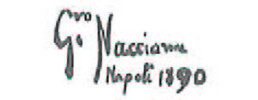
Nacciarone Gustavo *
NACCIARONE GUSTAVO
Napoli 1831 – 1929
Fratello del noto pianista Guglielmo, fu allievo a Napoli della Libera Scuola di Pittura di G. Bonolis. Sull’esempio di D. Morelli, affiancò al genere storico le tematiche neopompeiane e orientaliste e subì il fascino delle giapponeserie di moda. Esordì all’Esposizione borbonica del 1855 con La morte di Roberto, di-pinto di chiara matrice morelliana: la figura romantica dell’eroe-vittima, colto negli ultimi attimi di vita, fu un tema frequente nei suoi dipinti (La morte di Pergolesi, 1890, Napoli, Museo di San Martino). Appartengono alla sua copiosa produzione anche paesaggi (Posillipo da Chiatamone, esposto a Milano nel 1874) e scenette di genere. Partecipò con assiduità alle promotrici napoletane dal 1862 al 1894 (1862, Isabella Orsini col suo paggio;1866, Maria Stuarda nel Parco della Regina; 1869, Una fioraia; 1873, Gulhanam; 1879, Ogni canto nell’harem può essere così; 1881, Il mandolino; 1884, Nel Giappone; 1894, In cerca di sogni). Espose anche alle mostre di Milano (1869-1891), di Genova (1873, Cripta di San Germano; 1881, Pompei), di Torino (1874-1884), di Bologna (1888), di Palermo (1891-1892). All’estero fu presente alle esposizioni di Berlino nel 1883, di Londra nel 1888 e di Monaco di Baviera nel 1892. Decorò, in collaborazione con altri artisti, la residenza napoletana del barone G. Miceli.
